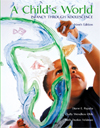 |
1 |  | 
Child development: Scientific study of change and from conception through adolescence. |
 |
 |
2 |  | 
In the studying of child development, scientists argue about the relative importance of and . |
 |
 |
3 |  | 
Today the study of child development is part of the broader study of which covers the entire life span. |
 |
 |
4 |  | 
The study of development is increasingly directed to the , , , and social policies applied to children. |
 |
 |
5 |  | 
The exploration of child development has evolved and matured to where today, there is a broad regarding fundamental points that have emerged. |
 |
 |
6 |  | 
change: Change in number or amount, such as in height, weight, or size of vocabulary. |
 |
 |
7 |  | 
change: Change in kind, structure, or organization, such as the change from nonverbal to verbal communication. |
 |
 |
8 |  | 
Growth of the body and brain, sensory capacities, motor skills, and health are part of the development. |
 |
 |
9 |  | 
Cognitive development includes mental abilities such as , , , ,and moral reasoning. |
 |
 |
10 |  | 
Change and stability in personality, emotional life, and social relationships constitute development. |
 |
 |
11 |  | 
An idea about how people view members of their particular society on the basis of shared subjective perceptions or assumptions defines . |
 |
 |
12 |  | 
: are differences among children in characteristic influences or development outcomes. |
 |
 |
13 |  | 
: Inborn influences on development, carried on the genes inherited from the parents. |
 |
 |
14 |  | 
environment: Totality of influences on development, external to the self. |
 |
 |
15 |  | 
:Unfolding of a genetically-influenced, often age-related, of physical changes and behavior patterns, including the readiness to master new abilities. |
 |
 |
16 |  | 
nuclear family: Two-generational economic, kinship, and living unit made up of parents and their biological or children. |
 |
 |
17 |  | 
extended family: Multigenerational kinship network of parents, children, and more distant relatives, sometimes living together in an - . |
 |
 |
18 |  | 
socioeconomic status (SES): Combination of economic and social factors, including income, , and occupation. |
 |
 |
19 |  | 
: Group united by ancestry, race, religion, language, and/or national origins, which contribute to a sense of shared identity. |
 |
 |
20 |  | 
: A society's or group's total way of life, including customs, traditions, beliefs, values, language, and physical products-all behavior passed on from adults to children. |
 |
 |
21 |  | 
characteristic of an event that occurs in a similar way for most people in a group. |
 |
 |
22 |  | 
influences are unusual events that happen to a particular person, or an event that happens at an unusual time of life. |
 |
 |
23 |  | 
period: Specific time during development when a given event will have the greatest impact. |
 |
 |
24 |  | 
plasticity: of performance. |
 |
 |
25 |  | 
:Group of people who share a similar experience, such as growing up at the same time and in the same place. |
 |



 2002 McGraw-Hill Higher Education
2002 McGraw-Hill Higher Education